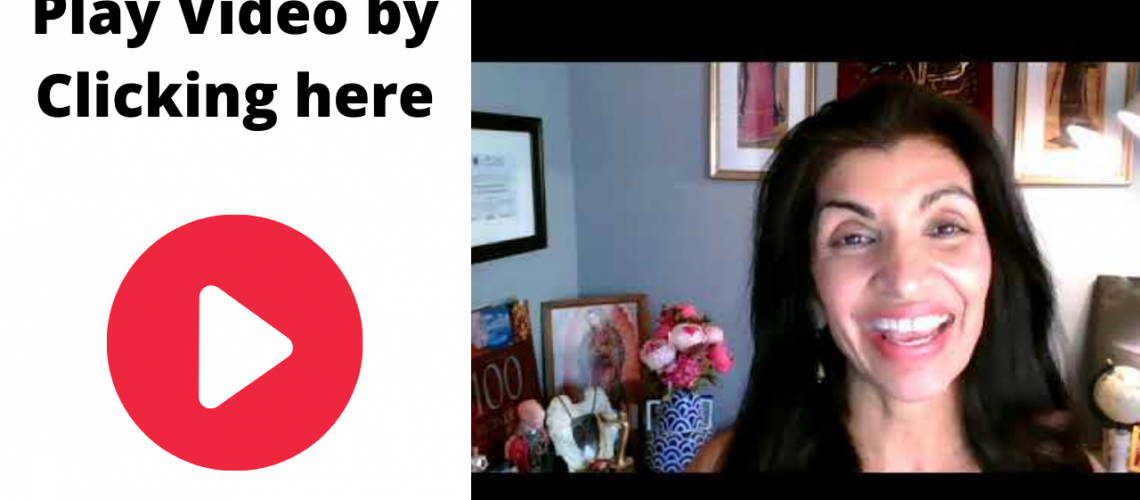Focus on What markers can help access
Hallmarks
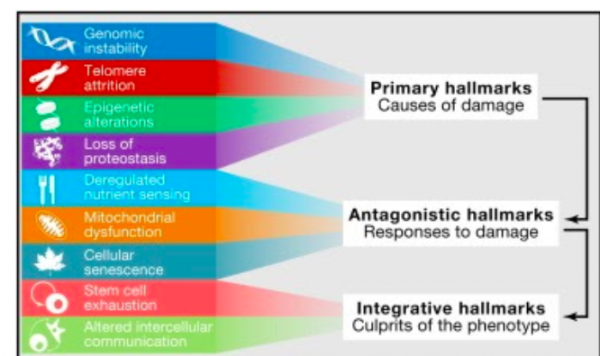
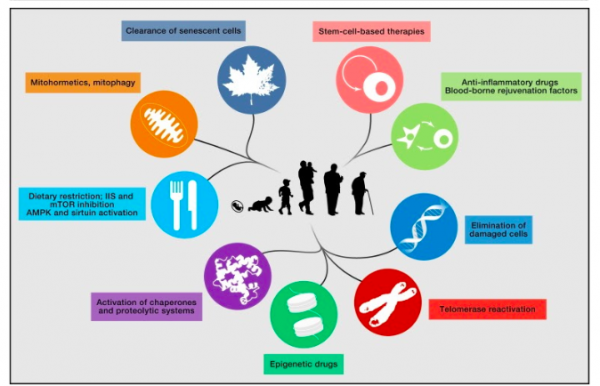
While Sinclair was in Guarente’s lab, David Sinclair discovered that Sirtuin 1 (called sir2 in yeast) slows aging in yeast by reducing the accumulation of extrachromosomal rDNA circles.
Others working in the lab at the time identified NAD as an essential cofactor for sirtuin function.
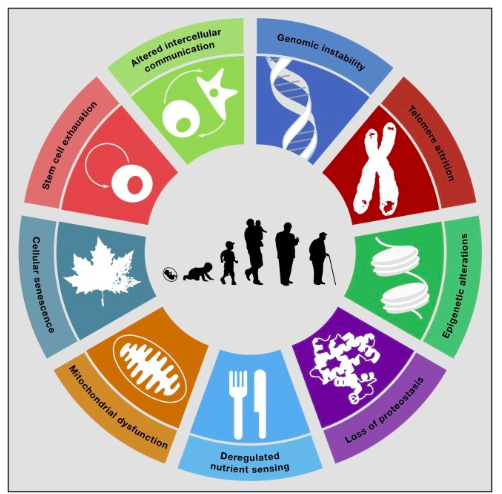
To prove that aging is a problem we can solve—and figure out how to stop. He argues that we can slow down the aging process, and in some cases even reverse it, by putting our body through “healthy stressors” that increase NAD levels and promote sirtuin activity. The role of sirtuins in aging is now fairly well accepted, but the idea that we can reactivate them (and how best to do so) is still being worked out.
Supplements and Recommendations
Nmn supplementsNMN is a direct and powerful (Nicotinamide Adenine Dinucleotide) NAD+ supplement. NMN was the actual compound used by scientists to reverse several longevity bio-markers in old mice, sparking worldwide interest in NAD research.
David Sinclair Takes:
- Resveratrol – 1g/daily – mornings with yogurt (see where to buy)
- Nicotinamide Mononucleotide (NMN) – 1g/daily – mornings (see where to buy)
- Metformin (prescription drug) – 1g/daily in the evenings – except on days when exercising
- Multivitamins? Only vitamin D3 with K2, he aims to get the rest from his diet
- Statin (prescription drug) – taken since his early 20s due to family history of cardiovascular disease
- Aspirin – 83mg daily
– Started taking resveratrol around 2004, and added NMN & Metformin approximately 3 years ago
– Resveratrol, NMN & Metformin doses come via David’s recently released book; Lifespan
– Daily vitamin K2, D3 and aspirin all also mentioned in his book Lifespan
– David discussed using a statin in his Jan 2019 Joe Rogan interview (link), but didn’t mention it in his book
His studies showed that without fat, resveratrol absorption was 5x lower. So consumption with yogurt (or another fat source) is important. David clarified on the recent podcast with Rhonda Patrick that the NMN doesn’t need to be taken with a fat source – he specifically mentions taking his NMN in capsules, downed with a glass of water in the morning.
What do Resveratrol & NMN do in relation to living longer?
David describes resveratrol and NMN as critical for the activation of sirtuin genes. Sirtuins play a key role in functions that help us to live longer – such as DNA repair.
He describes resveratrol as the “accelerator pedal” for the sirtuin genes (increasing their activation), and NMN as the fuel. Without “fuel”, resveratrol won’t work. The reason that resveratrol won’t work effectively without NMN, is that sirtuin activation requires youthful NAD levels, but by 50 years old, we have about half the level of NAD we had in our 20s (NAD being a molecule that is essential to energy production in our cells).
So in effect, you take resveratrol to increase activation of the sirtuin genes, and NMN to ensure the sirtuins have enough energy to work properly.
What else is David doing to stay healthy?
- Intermittent fasting – skipping breakfast and/or lunch where possible. Helped by lots of green tea
- Running 1-2x/week low impact and high intensity (using a curved treadmill such as Woodway)
- Weight lifting (ideally!) 2-3x/week
- Sauna weekly
- Coffee in the morning (once per day), then green tea after that
Below we’ll dig deeper into the 3 longevity supplements David takes; NMN, Resveratrol & Metformin.
Contents [hide]
- 1 Resveratrol
- 2 NMN – Nicotinamide Mononucleotide
- 3 Metformin
- 4 How to (big picture) think about the molecules David takes?
- 5 To Conclude…
Resveratrol

Resveratrol is a molecule that’s found (in small amounts) in the skin of foods like grapes, blueberries, raspberries, mulberries, and peanuts. If you remember the “hype” some time ago around red wine being healthy, part of that came because it contains tiny amounts of resveratrol. Unfortunately all foods sources contain tiny amounts, so we need to take it in a concentrated supplement form for it to be useful.
There’s actually a fair amount of controversy around the potential benefits of resveratrol. For example this 2019 literature review is quite critical of the health claims:
Whereas this paper (admittedly co-authored by David Sinclair), points to benefits:
In that paper they hypothesize that resveratrol acts a “caloric restriction memetic”, which activates beneficial cellular pathways.
Given that there are scientists much smarter than me on both sides of the fence, I find it hard to draw a conclusion. But certainly it’s interesting that a scientist like David has taken it since 2003 – and continues to do so to this day.

Left pic = 2009 (source), right pic = 2019 (source)
Resveratrol – Where to buy?
Whilst David’s resveratrol comes from excess product leftover from lab experiments, not all of us have this luxury! Therefore we are forced to look online. If you pop resveratrol into an Amazon search, you’ll find a host of different options, many of (potentially) dubious quality.
The first thing to note is that we should be looking for trans-resveratrol, not cis-resveratrol.

From David’s studies, cis-Resveratrol did not activate the sirtuin enzyme, but trans-Resveratrol did.
Next, the purity of the trans-resveratrol is important, we’re looking for 98%+. David mentions this at 1:17:54 of his Ben Greenfield interview, noting that 50% purity can even give diarrhea, because there’s other stuff that comes along with the molecule. He also confirms that Polygonum cuspidatum (Japanese Knotweed) is a good source for the resveratrol.
To get closer to the quality that David is likely taking, we can look at research published by an old company of his; Sirtris (who were sold to GSK for $720 million). In this paper they were doing clinical tests on a formulation of resveratrol they call SRT501. Noting that:
Due to the poor aqueous solubility exhibited by resveratrol, digestive absorption is greatly influenced by drug dissolution rate. In an effort to increase absorption across the gastro-intestinal tract and thus systemically available parent compound, there has been considerable interest in the pharmaceutical manipulation of resveratrol. Decreasing the particle size of such chemicals can improve their rate of dissolution and thus their absorption. Therefore, the aim of this clinical study was to investigate whether consumption of SRT501, a micronized resveratrol formulation designed by Sirtris, a GSK Company is safe and generates measurable and pharmacologically active levels of parent agent in the circulation and in the liver.
That’s a wordy quote from the paper, but in essence, they were testing a micronized resveratrol formulation against a non-micronized version. Their study found that levels of resveratrol in the blood were 3.6x greater when using the micronized formulation, and other markers they were comparing also improved.
We see this with other molecules too; where reducing particle size increases bioavailability. For example with curcumin, whose absorption can be improved through micronization (for example Theracurmin). So this makes sense.
Searching Amazon for “micronized resveratrol” suddenly shrinks the options to just a few, including MegaResveratrol. However, I noticed something on the page for the Rich Roll interview with David Sinclair. He lists a micronized resveratrol by RevGenetics. This was interesting because during the interview Rich asks David where to get the supplements he takes, and David told him they’d talk about it after the podcast. Maybe RevGenetics was a brand that David mentioned post interview (possible), or perhaps it was just a brand Rich “plucked” from a Google search. Impossible to know without further info.
That said, I looked into RevGenetics a little more, and they certainly seem legitimate, with a high rating on ShopperApproved. They focus on longevity molecules and have been selling resveratrol since 2006. They offer a micronized 98% trans-resveratrol that comes in powder form, and thus could be taken in the morning with yogurt, as David does. It’s named M98 Super Micronized Resveratrol.
If like me, you’re curious about the daily cost… at 1g/day it works out at $3/day ($75 per 25g tub). If you buy 2 or 3 tubs you get a discount, and it comes down to $67.50 per tub, so $2.70/day.
Note: Whichever source of trans-resveratrol you take, ensure to mix it with a fat source (such as yogurt or olive oil) in order to maximize bioavailability.
Resveratrol – Storage

David mentions in his interview with Rhonda Patrick a few nuances around the storage of resveratrol:
- Resveratrol is light sensitive, and when left exposed to light it turns brown. They found that brown resveratrol no longer works correctly.
- Ideally resveratrol should be kept in the cold and dark – for example, in a sealed container in the fridge.
Homemade Yogurt
David Sinclair Homemade Yogurt –

NMN – Nicotinamide Mononucleotide
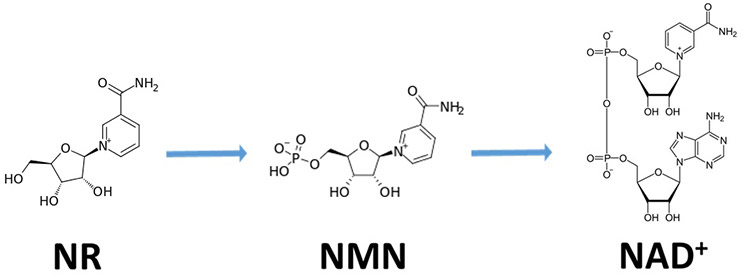
NMN falls into a category of supplements, along with Nicotinamide Riboside (NR), referred to as “NAD boosters” – which have become increasingly popular.
NAD is required for every cell of our body to help facilitate energy production. As we age, the amount of NAD our cells produce declines, and less NAD = reduced cellular function. According to David, at 50, you have about half as much NAD as at age 20.
The hope is that by supplementing precursors we can boost the cellular level of NAD closer to youthful levels.
There’s little to no doubt in the research community that we need to restore NAD function; but the jury is still out on what the best method will be. Currently David has his eggs in the basket of NMN.
NMN – Where to buy?
David’s NMN powder comes from excess product left over from lab experiments. This is good to know, but doesn’t help us when it comes to sourcing some. Below we will look at various possible buying options.
Potential considerations when buying include:
- Accuracy – is the product you’re getting actually NMN?
- Purity – assuming it is NMN, how pure is it? 90%… 95%…?
- Contaminants – does it contain any contaminants such as heavy metals?
- Fillers – are any fillers used, and if so, what % do they account for of the overall powder?
Assuming all the above are ok, the last crucial question is:
- Price – how much does it cost per gram?
Searching online there are a large number of possible options. Without doing ones own 3rd party lab testing, it’s hard to evaluate the quality of products. What I’ve done below is put some of the more highly reviewed options into a table, calculated the approximate price per gram, and added links to any 3rd party analysis certificates the companies display.
| Product | Approximate price per gram | 3rd Party Analysis Certificate? |
|---|---|---|
| ProHealth Longevity | $5.33/gram ($80 / 15g) | Yes – link |
| Double Wood | $6.53/gram ($49 / 7.5g) | Yes – link |
| Super NMN | $6.08/gram ($152 / 25g) | Yes – link |
| RevGenetics Advanced NMN | $15.8/gram ($395 / 25g) | Yes – link |
| No 3rd Party Analysis Certificate | ||
| Maac10 | $6.5/gram ($24 / 3.75g) | None I can find |
| Genexx Powder (3x 15g tub) | $5/gram ($225 / 45g) | Their website says yes – but can’t find it |
The above table provides a start, but for a detailed analysis table see this companion post.
– Price per gram
The average price per gram appears around $5-$6. For products dramatically lower in price than this, it would be worth exercising some caution around their quality.
– Capsulating the Powders
With the bulk powder versions of NMN above, you could put them into capsules yourself at home, using a cheap, but handy, capsule filling machine. Emulating the method David uses to take his NMN; in capsules swallowed with a glass of water.
– Testing
It’s perhaps worth noting that none of the companies (besides RevGenetics) have demonstrated testing for impurities such as heavy metals, solvents or bacteria – they only test for NMN purity.

NMN Price & Bioavailability
One thing that’s worth acknowledging is that NMN is currently a very expensive supplement, especially if you wanted to emulate David Sinclair’s dosage of 1g/day.
There are a few possible workarounds:Possible Price Workarounds – Click to Expand
What does David think of Nicotinamide Riboside (NR)?
Nicotinamide Riboside is a precursor to NAD, similar to NMN. David states in his book that his lab finds:
- NMN a more stable molecule than NR
- NMN is able to do some things in mice studies that NR can’t
That being said, he isn’t against NR, he’s just more optimistic on NMN being the better molecule for raising NAD in the long run. He notes in a blog post on NMN & NR that:
- The science is further along for NR, but it’s too early to say which is better for humans.
NR – Where to buy?

The brand leader in sales of Nicotinamide Riboside is Chromadex’s Niagen (pictured above). Amongst Chromadex’s scientific advisors is Charles Brenner, who first discovered NR, and showed it could extend the life of yeast cells.
Niagen’s recommended serving size is 300mg (1 capsule) – which may be less efficient at raising NAD levels than 1g of NMN.
If we compare NR & NMN at a price per gram, they’re more similar than I expected. Niagen works out approximately $5.22/gram, and NMN is around $5-$6/gram depending on brand.
NR & NMN Storage
In David’s recent interview with Rhonda Patrick, he discussed details around storage, saying:
- NR and NMN need to be kept cold (fridge or freezer) because they don’t have a long shelf life.
- If they are kept on a shelf, and are not in a stabilized form, they can degrade into nicotinamide. This is sub-optimal because Nicotinamide can have the opposite of the desired effect, and actually inhibit the sirtuins1. He didn’t elaborate further on what a “stabilized form” means in this context, which would be interesting to know.
- If NMN gets wet, or gets a bit of humidity in the bottle, its only a short time before it’s degrading. This may be the case with NR too (because it applies to many supplements), but when David explained this he was explicitly talking about NMN.
Since David explained this I’ve come to learn that Nicotinamide Riboside, when it its chloride form; Nicotinamide Riboside Chloride (as sold by Niagen), is in a stabilized form. This means that it doesn’t need to be kept cold to have an adequate shelf life. More on that below…Further Details on Stabilized NR – Click to Expand
NMN/NR & Methyl Group Depletion?
There has been some concern in the field that consuming NR or NMN could decrease the body’s methyl groups and lead to health problems. This section will discuss that issue…
So methylation itself, which utilizes methyl groups (CH?), is an essential process for a host of critical functions in the body, including regulation of gene expression and the removal of waste products.
Consuming Niacin derivatives (which includes NR and NMN) will require the body to use up methyl groups in order to later degrade and excrete them. There has been some discussion and concern that by increasing the amount of methylation the body needs to do (through supplementation of NR/NMN), we might deplete the body of methyl groups needed to carry out essential processes.
David discussed this in his podcast with Paul Saladino (see 44mins mark), acknowledging that Niacin derivates (including NR/NMN) require methylation for excretion, but asserting that at this stage the idea of methyl depletion is anecdotal, and not something that has been shown in any NR/NMN studies.
David says that in an abundance of caution he’s making sure he gets enough methyls in his diet. He mentions having used supplement called betaine (also known as trimethylglycine), which he says is a powder you can eat, and doesn’t taste too bad. But says what he now does is take a combination of methyl folate plus methyl B12 – and feels like that’s his best solution to this (potential) problem.
David doesn’t cite a particular brand that he uses, but options include Jarrow Methyl B-12/Methyl Folate & Pure Encapsulations – B12 Folate.

Methyl groups are primarily derived from nutrients in the diet, including; methionine (amino acid), folate (vitamin B9), choline, betaine, riboflavin (vitamin B2), pyridoxine (vitamin B6) and cobalamin (vitamin B12). For foods rich in these, see the table below (source):
| Choline | Cauliflower, eggs, flax seeds, lentils, liver, peanuts, soybeans and wheat germ |
| Folate and folic acid | Asparagus, cheese, eggs, fortified breads and cereals, legumes, liver, peanuts, oranges and spinach |
| Methionine | Dairy products, eggs, fish, meat, poultry and rice |
| Vitamin B2 (Riboflavin) | Cheese, eggs, meat and milk |
| Vitamin B6 (Pyridoxine) | Bananas, fish, grains, legumes, liver, meat, potatoes and poultry |
| Vitamin B12 (Cobalamin) | Eggs, fish, meat, poultry, dairy products |
A further source to add to this discussion is the research done by Chromadex. They hold a patent on nicotinamide riboside production, and make Niagen. In a tweet thread by their chief scientific adviser Charles Brenner, he explains that Chromadex took the potential risk of NR depleting methyl groups seriously. To test this they performed a randomized double blind placebo controlled trial administering 100, 300, or 1,000?mg of NR over 56 days (study link). They used homocysteine levels as a proxy for methylation disturbance, and found no change to homocysteine in any of the dosage groups, including up to 1,000mg (see this image). If there was a shortage of methyl groups, they would have expected to homocysteine levels rise. Worth noting that study used NR, not NMN.

Metformin

Metformin is actually a relatively old drug, first discussed in medical literature in 1922, and studied in humans in the 1950s. It is derived from a plant called the French Lilac. It’s primary use in medicine is for the treatment of diabetes, thanks to its ability to decrease blood glucose levels in patients.
Because Metformin has been used for years, and has an established track record of safety, this makes it more attractive as a longevity drug. Molecules that are discovered today will need years of testing before they can even come close to rival the amount of data and “patient years” accumulated by metformin.
It’s thought the longevity benefits are at least in part derived from activation of the AMPK cellular pathway. This has a host of knock-on effects (visualized below), some of which are involved in beneficial processes like mediating inflammation and increasing autophagy (cellular cleanup).

AMPK pathway activation (image via this paper)
Metformin – Where to buy?
Metformin is a prescription drug, and thus needs to be acquired through a doctor’s prescription, at least in most countries. It isn’t (yet) considered a drug that can help improve healthspan or lifespan, and so you may need to find a forward thinking doctor if you want it prescribed for general health. Typically doctors only prescribe Metformin for blood sugar control issues (type 2 diabetes).
Metformin – How often to take?
Typically Metformin is taken daily – both by diabetics, and by people using it for healthspan extension. However, on the latest interview with Joe Rogan, they discussed a 2018 paper which showed metformin inhibits mitochondrial adaptations to aerobic exercise training. David explained that this makes sense, and its exactly metformin’s inhibition of mitochondrial function that leads to some of the health benefits. Specifically, they cause the cell to think it’s in a nutrient restricted state, and it turns on pathways typically reserved for times of scarcity. The function of these pathways is hypothesized to lead to better healthspan outcomes.
With this in mind, David opts to take metformin at night, so that come the morning, the mitochondrial inhibition is lessened. He also opts not to take it on days when he has been exercising.
How to (big picture) think about the molecules David takes?
We can attempt to summarise the function of the molecules David takes using 2 categories; 1) molecules that emulate fasting 2) molecules that boost existing function.
1) Molecules that emulate fasting
Both resveratrol and metformin can be described as molecules that trigger cells to exhibit characteristics similar to when fasting. Metformin activates AMP-Kinase, Resveratrol activates SIRT1 and AMP-Kinase.
Why is this beneficial?
Cells have evolved to operate in 2 main states; fed and unfed. In times of plenty, they will grow and multiply, and in times of scarcity, they will hunker down and focus on maintenance. Part of maintenance includes things like:
- DNA repair
- Removing and re-using non-functioning or superfluous cellular contents (autophagy)
- Removing toxins
These are all important tasks, and it’s possible that when we exist in a constantly fed state, they don’t get performed as often as may be optimal.
Thus when David takes resveratrol and metformin, and undertakes intermittent fasting, he’s allowing for these fasting dependent processes to take place.
There may be other things going on too – but this is a big chunk of what’s happening.
2) Molecules that boost existing function
Whilst metformin and resveratrol are primarily aimed at preserving existing function, we have NMN which is taken to boost our NAD back to youthful levels.
Fasting can actually boost NAD levels too, but the intention is that using NAD precursors like NMN raises NAD higher and for longer than can be achieved otherwise.
TEST TO FIND BIOLOGICAL AGE
Commercial tests typically measure telomere lengths or amounts of telomeric DNA in a blood sample. Companies compare your telomeres to telomeres from people of similar age to try to determine the biological age of your blood cells. … In a way, telomeres follow the Goldilock’ principle.










